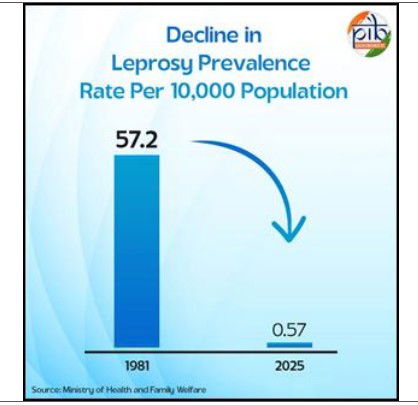Health
99 pc drop in prevalence rate of leprosy in India in last 44 years: Govt

New Delhi, Oct 6
India has seen a remarkable success in control of leprosy, with a 99 per cent drop in prevalence rate per 10,000 population and 98 per cent reduction in cases under treatment over a span of 44 years, according to the government.
As per an official statement, India in 2025 had a prevalence rate of 0.57 per 10,000 population and 0.82 lakh patients on treatment. In stark contrast, the country in 1981 had a prevalence rate of 57.2 per 10,000 population and 39.19 lakh patients on treatment.
Since March 2006, when the annual report confirmed a prevalence rate of less than 1 per 10,000 (0.84), there has also been a decline of 37 per cent in new case detection.
Leprosy, or Hansen’s disease, is a chronic infectious disease caused by Mycobacterium leprae bacteria. Symptoms include discoloured skin patches, lack of ability to feel touch, pressure, pain, muscle weakness, deformities, particularly in hands, feet, and face, and the inability to close eyes and poor vision.
The disease is transmitted through droplets from the nose and mouth during close and frequent contact with untreated cases.
A key strategy in the fight against the disease was the introduction of Multidrug Therapy (MDT) containing bactericidal drug Rifampicin and bacteriostatic drug clofazimine, besides dapsone, in 1983, the government said.
Early diagnosis and treatment with MDT prevented disabilities and deformities, marking the beginning of the National Leprosy Eradication Programme (NLEP) -- a centrally sponsored scheme under the National Health Mission (NHM).
“NLEP programme demonstrates a public health success rooted in political will, commitment, sustained efforts for new case detection, free of cost and uninterrupted supply of MDT drugs, timely adoption of global guidance, timely introduction of revised treatment regimens, post-exposure prophylaxis, innovations, and expanding community engagement,” the statement said.
With the successful implementation of NLEP, "India achieved elimination status in March 2005 at the national level, which means prevalence rate below 1 per 10,000 population and sustained this till date," the statement said.
"Since then, the programme is working towards achieving this goal at the sub-national level as of March 2025, 31 states and 638 districts have achieved a prevalence rate below 1 per 10,000 population," it added.
Leprosy screening has also been integrated under Ayushman Bharat Yojana, Rashtriya Bal Swasthya Karyakram (RBSK), and Rashtriya Kishore Swasthya Karyakram (RKSK) for screening of adults and children.
NLEP is aligned with the National Strategic Plan and Roadmap for Leprosy 2023- 2027 and the WHO Roadmap for Neglected Tropical Diseases 2021-2030, aiming to achieve interruption of transmission of leprosy by 2030.
"As India approaches its goal of zero transmission, continued political will, adequate funding, and active public involvement will be key," the statement said.







































